Lion’s mane jellyfish is known as the weirdest animals due to their large size. The other names for lion’s mane jellyfish are hair jelly, giant jellyfish, and arctic red jellyfish. These magnificent creatures can be found in the Arctic, Atlantic, and Pacific Oceans.
The lion’s mane jellyfish is a true marvel of the ocean world. These are not hard to spot with their distinctive yellow, red, and brown coloration. Despite its impressive size, the lion’s mane jellyfish feeds mainly on small fish and plankton.
Curious about how the lion’s mane jellyfish got their name? Want to know more about how they capture their prey? Keep reading to discover fascinating facts about these incredible creatures. Their role in the marine ecosystem is also discussed here. So, ready to dive in? Let’s go!
About Lion’s Mane Jellyfish – A Quick Biology
Here is a quick biology table for these lion’s mane jellyfish:
| Parameters | Details |
| Scientific name | Cyanea capillata (Linnaeus, 1758) |
| Kingdom | Animalia |
| Family | Cyaneidae |
| Genus | Cyanea |
| Phylum | Cnidaria |
| Class | Scyphozoa |
| Order | Semaeostomeae |
| Species | C. capillata |
| Habitat | Lives in cool waters |
| Diet | Small fishes, fish larvae, tiny crustaceans, copepods, and other jellies |
| Life Span | One year |
| Geographical range | Arctic and north Pacific Ocean, from Alaska to Washington |
| Size | 36 meters |
| Weight | 200 lbs. |
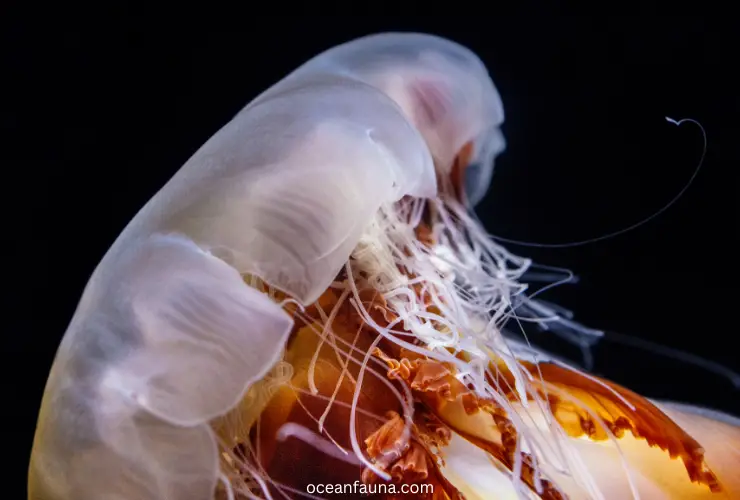
Description And Taxonomy of Lion’s Mane Jellyfish
The lion’s mane jellyfish is a fascinating and mysterious creature that has captured the attention of people all around the world. With its translucent body and long, flowing tentacles, this jellyfish is both beautiful and deadly. It plays an important role in marine ecosystems, serving as both predator and prey.
However, there is some debate among zoologists regarding the taxonomy of the Cyanea species. Some suggest that all species should be classified as one. However, some say two distinct taxa coexist in at least the eastern North Atlantic.
The blue jellyfish, scientifically referred to as Cyanea lamarckii Péron & Lesueur, 1810, possesses distinct characteristics. These features differentiate it from the lion’s mane jellyfish. Unlike the latter, the blue jellyfish displays a blue hue rather than a red one. It is also much smaller in terms of size.
Its diameter ranges between 10 to 20 cm (3+7⁄8–7+7⁄8 inches), although on rare occasions, it can grow up to 35 cm (14 inches) in size. Populations of the lion’s mane jellyfish are sometimes referred to as Cyanea nozakii or C. c. nozakii in the waters around Japan.
Recently, Russian researchers announced the discovery of a possible sister species in the White Sea. These were named Cyanea tzetlinii. However, the species has yet to be recognized by authoritative databases such as WoRMS or ITIS.
Physical Characteristics of Lion’s Mane Jellyfish
Here are some amazing physical characteristics of a lion’s mane jellyfish:
- Showy, trailing tentacles resembling a lion’s mane
- Vary greatly in size, and can reach over 2 meters in diameter
- Bell divided into eight lobes, resembling an eight-pointed star
- Each lobe has 70-150 tentacles arranged in four rows
- Balance organ at each lobe helps the jellyfish orient itself
- Broad frilly oral arms with stinging cells extend from the central mouth
- The total number of tentacles is around 1,200
- Long, thin tentacles from subumbrella are extremely sticky and have stinging cells
The location of larger lion’s mane jellyfish is further offshore than smaller ones. Young jellyfish have different colors than adults. Some juveniles are lighter orange or tan, and very young ones are sometimes colorless. As they age, adults become red and start to darken.
According to NCBI research, the lion’s mane jellyfish has incredibly long tentacles. The longest known tentacles on record are 36.6 m (120 ft) long, which is longer than a blue whale.
It has been suggested that this specimen may belong to a different Cyanea species. This impressive length has earned the lion’s mane jellyfish a spot among the world’s longest animals.
The biggest lion’s mane jellyfish ever recorded was discovered in 1865 off the coast of Massachusetts. It had a bell measuring 7 feet (210 cm) in diameter and tentacles extending a whopping 120 feet (36.6 m) in length!
Behaviors of Lion’s Mane Jellyfish
Lion’s mane jellyfish usually stay near the water surface, not more than 20 m (66 ft) deep. They move slowly and depend on ocean currents for travel. In late summer and autumn, jellyfish grow large.
They are usually carried by ocean currents. They can easily be spotted near the shore. Unlike most jellyfish, they don’t move in groups and are mostly solitary.
Here are a few additional behaviors of lion’s mane jellyfish:
- Cannibalistic tendencies: Lion’s mane jellyfish have been known to feed on other jellyfish. They eat their own kind when food sources are scarce.
- Diurnal vertical migration: Lion’s mane jellyfish stay near the surface during the day. They migrate to deeper waters at night to find food.
- Regeneration: Lion’s mane jellyfish can regenerate their tentacles and bell. They possess this ability in case they are damaged or lost due to predation or other causes.
You can also read the reproductive behavior, feeding behavior, and predatory behavior in their respective sections.
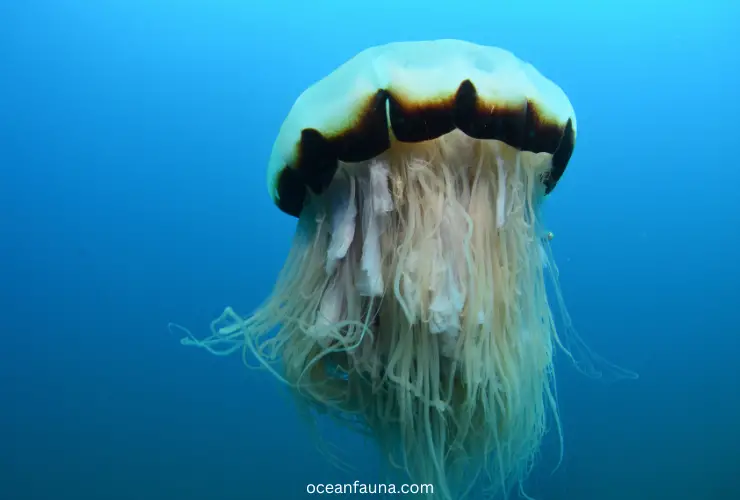
Habitat, Range, And Distribution of Lion’s Mane Jellyfish
The lion’s mane jellyfish is typically found in frigid waters all over the world. Mostly, they are found in the Arctic, northern Atlantic, and northern Pacific Oceans. This magnificent creature can be spotted in various locations, including the following:
- English Channel
- Irish Sea
- North Sea
- western Scandinavian waters
Thus, they are ranging from the south to Kattegat and Øresund. While it may occasionally drift into the southwestern part of the Baltic Sea, it cannot breed in these low-salinity waters.
More interestingly, similar jellyfish that may belong to the same species are known to inhabit seas near Australia and New Zealand.
They are showcasing the versatility and adaptability of this fascinating creature across different oceanic regions. Lion’s mane jellyfish have been spotted in the larger bays of the East Coast of the United States, below 42°N latitude. This observation has been consistent for some time now.
Diet / Feeding Habits of Lion’s Mane Jellyfish
The lion’s mane jellyfish relies on its long, stinging tentacles to catch and consume a variety of prey. Its diet can include fish, zooplankton, other sea creatures, and even smaller jellyfish that happen to cross its path.
Their tentacles are covered with thousands of tiny stinging cells. These are called nematocysts which are used to paralyze their prey. The tentacles bring it to the jellyfish’s oral arms Once the prey is captured. It has small, hair-like cilia that move the food to the mouth.
The mouth leads to a central digestive cavity where the food is broken down and absorbed. These sea jellies are opportunistic predators. It means that they will eat almost anything they come across. They are also known to scavenge on dead animals in the water.
Lion’s mane jellyfish have been observed feeding on small animals caught in fishing nets. These jellyfish can consume prey that is up to one-third of their own body size. This ability to eat such large prey is due to their specialized feeding structures and digestive system.
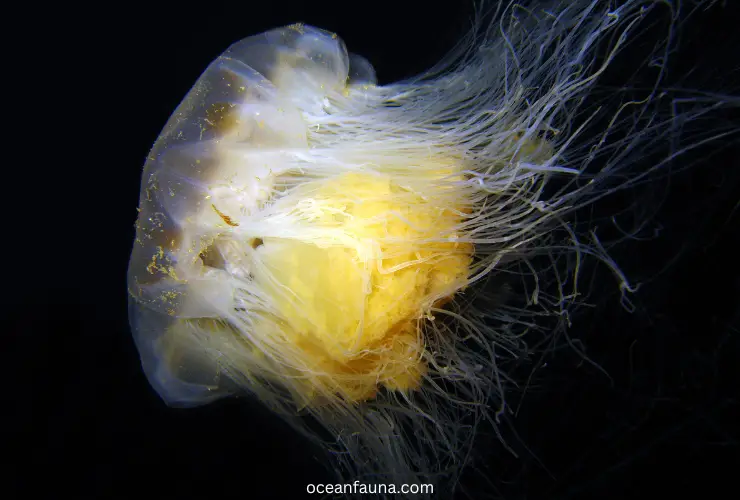
Life Cycle And Reproduction System of Lion’s Mane Jellyfish
Lion’s mane jellyfish have a complex reproductive system that includes both sexual and asexual methods. During the breeding season, male and female jellyfish release their gametes into the water.
Now, the fertilized eggs develop into planulae. The planulae are small larvae that swim freely in the water. After a few days, the planulae attach themselves to a solid surface and develop into polyps.
The polyps of the lion’s mane jellyfish have the ability to reproduce asexually by budding. A bud grows from the side of the polyp and develops into a juvenile jellyfish called an ephyra.
The ephyra is released from the polyp and begins its life as a free-swimming jellyfish. As the ephyra grows, it will develop into an adult jellyfish.
The lifecycle of the lion’s mane jellyfish can vary depending on the environment and availability of food. In optimal conditions, the jellyfish can reach sexual maturity within a few months and can live for up to a year after that.
However, if conditions are not favorable, the jellyfish can stay in the polyp stage for years. It delays the development of the ephyra.
Cardiovascular And Nervous System of Lion’s Mane Jellyfish
Lion’s mane jellyfish have a simple cardiovascular system. It consists of a central ring-shaped canal that branches out into smaller radial canals. These canals are lined with cilia. They create water currents that move nutrients and waste throughout the jellyfish’s body.
The jellyfish also has a simple nervous system. It consists of a nerve net located in the epidermis. This nerve net allows the jellyfish to sense touch and respond to stimuli like light or chemicals in the water. The jellyfish lacks a brain or any complex organs.
However, it does have a primitive sense of orientation, which allows it to move towards or away from light. Moreover, these sea jellies also lack bones, an excretory system (only the mouth is used for eating and excretory purpose), eyes, or blood. Their bodies are 95 percent water.
Cultural Popularity of Lion’s Mane Jellyfish
In the Sherlock Holmes short story “The Adventure of the Lion’s Mane”, a professor is found dead. He died after swimming and shouting “the lion’s mane.” Initially, suspicion falls on his romantic rival until the latter is also attacked.
If revealed the true killer is a lion’s mane jellyfish. The professor’s weak heart caused his death, as confirmed by the survival of the second victim.
There was a widely circulated photo on the internet showing a massive lion’s mane jellyfish. It appeared to dwarf a diver nearby several times. However, the photo was later found to be a hoax.
The image was created using a photo editing program. Also, the jellyfish was enlarged and superimposed onto the picture. The hoax generated a lot of attention and sparked discussions about the existence of such large jellyfish.
In the QI television program, it was mistakenly claimed that the lion’s mane jellyfish was the longest animal in the world. However, in 1864, a bootlace worm measuring 55 m (180 feet) was found washed up on the coast of Fife, Great Britain. Despite this, the claim is disputed as bootlace worms can stretch several times their natural length, so it is unclear whether the worm was actually that long.
Predators of Lion’s Mane Jellyfish
Here is a list of predators of lion’s mane jellyfish given in the table below:
| Predators | Prey Stage |
| Seabirds | Juveniles |
| Larger fish | Juveniles |
| Other jellyfish species | Juveniles |
| Sea turtles | Juveniles, both |
| Anemones | Juveniles, both |
| Leatherback sea turtles (big enemy) | Both |
Relationship between Lion’s Mane Jellyfish And Humans
The lion’s mane jellyfish has both positive and negative relationships with humans. They are a popular attraction for tourists who enjoy observing them in their natural habitat.
However, their stinging tentacles can be dangerous to humans. We will discuss it in our next section.
The lion’s mane jellyfish can also become a nuisance to fishermen. They can clog fishing nets and damage equipment. In some cultures, they are considered a delicacy and are consumed as food.
Overall, the lion’s mane jellyfish plays a complex role in human society. They are serving as both a source of fascination and a potential danger.
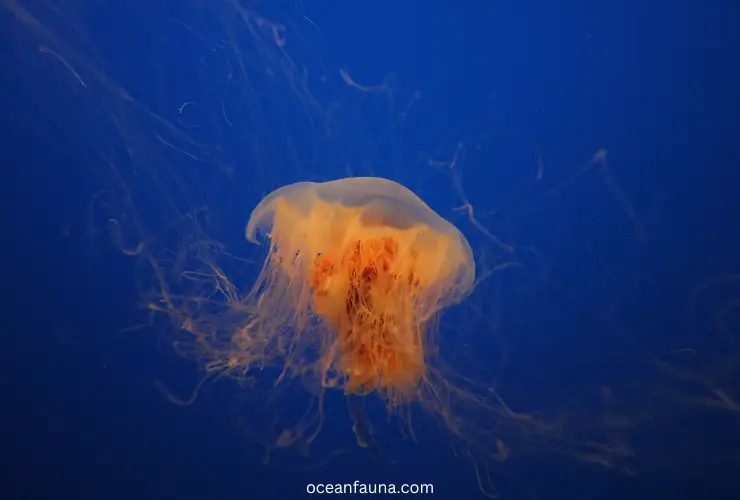
Do Lion’s Mane Jellyfish Sting?
Yes, lion’s mane jellyfish can sting. The stinging cells contain tiny harpoons that can penetrate human skin. The severity of the reaction can depend on the size of the jellyfish and the amount of venom injected. It is important to avoid contact with lion’s mane jellyfish.
In July 2010, a group of 150 beachgoers suffered stings from Lion’s mane jellyfish remains. It happened at Wallis Sands State Beach in Rye, New Hampshire, USA. It is possible that only one specimen was responsible for this incident due to the size of the species.
This event demonstrates the importance of being aware of jellyfish presence in the water. It also tells us to take precautionary measures to avoid being stung.
What Are the Effects of a Lion’s Mane Jellyfish Sting?
The effects of a lion’s mane jellyfish sting may include:
- Pain: Stings from lion’s mane jellyfish can be extremely painful. According to the reports, the pain lasted for hours or even days.
- Skin irritation: The sting may cause redness, swelling, and itching around the affected area.
- Nausea and vomiting: Some people may experience gastrointestinal symptoms such as nausea, vomiting, and diarrhea.
- Muscle weakness: In severe cases, stings from lion’s mane jellyfish can cause muscle weakness and even paralysis.
- Breathing difficulty: In rare cases, a sting can lead to respiratory distress or even respiratory failure.
- Cardiac arrest: In extremely rare cases, stings can lead to cardiac arrest and death. It happens particularly in individuals who are already weakened or have pre-existing medical conditions.
It is important to seek medical attention if you are stung by a lion’s mane jellyfish. You should visit the hospital particularly if you experience any of these severe symptoms.
How to Avoid a Lion’s Mane Jellyfish Sting?
Here are some tips to avoid a lion’s mane jellyfish sting:
- Be aware of the season: Lion’s mane jellyfish are most commonly found in the water from late spring through early summer.
- Watch for signs: Keep an eye out for warning signs posted at beaches. These signs may indicate that jellyfish are present in the water.
- Avoid touching jellyfish: Do not attempt to touch or handle jellyfish, even if they appear to be dead or washed up on shore.
- Stay clear of tentacles: If you see a jellyfish in the water swim around it or back away slowly to avoid contact with its tentacles.
- Use caution when diving or snorkeling: Be cautious when diving or snorkeling in areas where jellyfish are present. Avoid touching the ocean floor or any surfaces where jellyfish may be lurking.
Are Lion’s Mane Jellyfish Endangered?
The lion’s mane jellyfish is not currently listed as an endangered species. The IUCN Red List has also not evaluated its population status and conservation status.
However, it is not endangered. But, they can be affected by human activities such as pollution and overfishing just like other aquatic animals.
Lion’s mane jellyfish populations have increased due to the depletion of their natural predators in some areas. They may be threatened by habitat destruction or other factors in some other areas. It is important to manage human impacts on marine life to ensure the continued survival of lion’s mane jellyfish.
FAQs
Are lion’s mane jellyfish bigger than blue whales?
Yes. Lion’s mane jellyfish are bigger in length as compared to whales. Whales are only 33 meters long. However, the lion’s mane jellyfish can be 36.5 meters long.
Is the lion’s mane jellyfish the biggest jellyfish?
Yes, the lion’s mane jellyfish is considered the largest jellyfish in the world. These are also known as Cyanea capillata. The bell (body) of an adult measures up to 2 meters (6 feet 7 inches) in diameter.
Its tentacles extend up to 30 meters (100 feet) in length. However, other species of jellyfish can have longer tentacles or greater mass. These may include the Nomura’s jellyfish (Nemopilema nomurai) and the Arctic lion’s mane jellyfish (Cyanea nordmanni).
Are lion’s mane jellyfish immortal?
No, lion’s mane jellyfish are not immortal. They can regenerate their body parts. Still, they have a lifespan and eventually die like all living creatures.
Conclusion
So, the stunning appearance and long tentacles make it a unique creature of water. It’s like a disco ball mixed with a spaghetti monster. These sea creatures are majestic and fascinating. But beware, their sting can put a damper on any beach day. So next time you see one, admire it from afar and keep your distance.

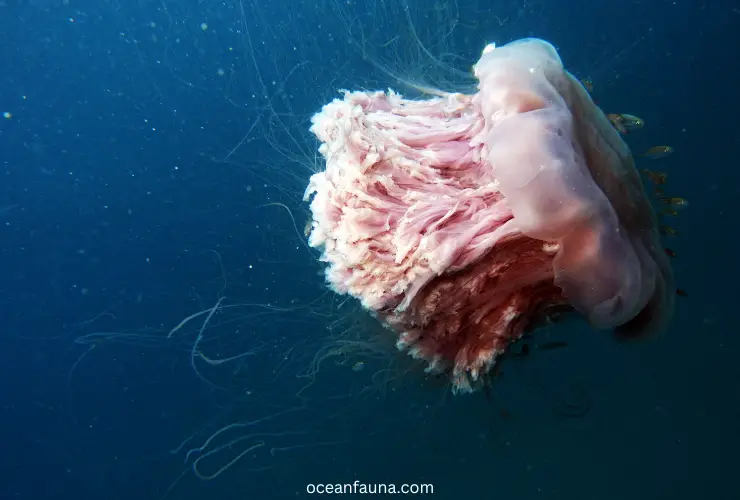
1 thought on “Lion’s Mane Jellyfish: Habitat, Diet & Other Facts ”